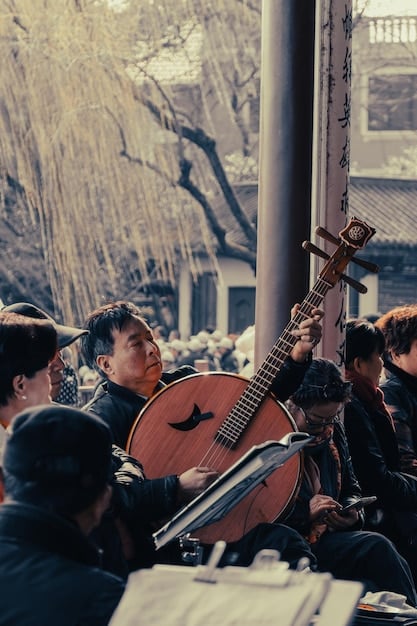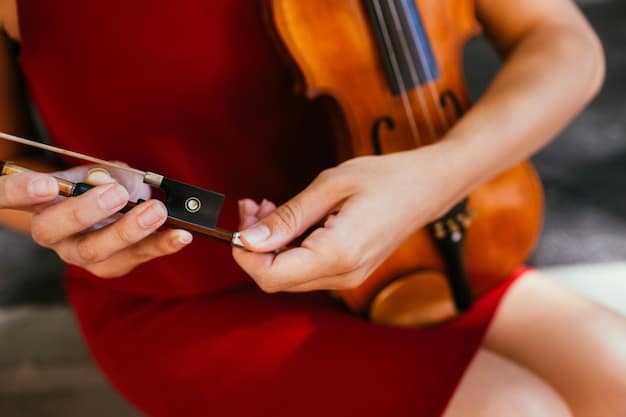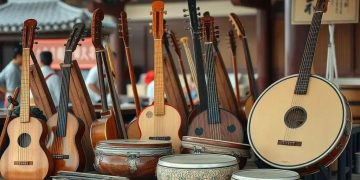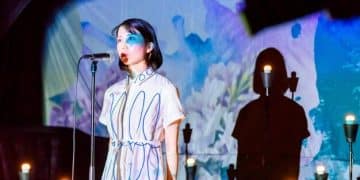Exploring Korean Traditional Music in the US: A Guide

Korean Traditional Music: Exploring the Sounds of Korea in the US encompasses a rich heritage of instruments, vocal styles, and performance practices, offering unique cultural experiences and musical traditions for audiences across America.
Delve into the enchanting world of Korean Traditional Music: Exploring the Sounds of Korea in the US, where ancient melodies meet modern audiences. This journey will introduce you to the captivating sounds and cultural significance of Korean music as it resonates within the vibrant tapestry of American life.
Korean Traditional Music: An Introduction
Korean traditional music, known as Gugak, embodies centuries of Korean history and culture. This introduction explores the rich tapestry of Korean sounds, introducing key instruments and musical forms that have found a home in the United States.
From royal court music to folk songs, Korean traditional music has a diverse range of styles and purposes, reflecting its deep roots in Korean society and its evolving presence in the American cultural landscape.
What is Gugak?
Gugak refers to the national music of Korea, encompassing various genres such as court music, aristocratic music, and folk music. Its development has been influenced by historical events, philosophical ideas, and the everyday lives of Koreans.
Unique characteristics of Gugak include its modal scales, rhythmic complexity, and the incorporation of diverse instruments and vocal styles to express a wide array of emotions and stories.
Key Instruments in Korean Traditional Music
Several unique instruments are central to Korean traditional music, each contributing distinct sounds and textures to the overall musical experience. Understanding these instruments is key to appreciating the depth of Gugak.
- Gayageum: A traditional Korean zither with 12 strings, played by plucking the strings with the fingers.
- Haegeum: A two-stringed vertical fiddle that produces a piercing and evocative tone.
- Piri: A cylindrical double-reed bamboo flute used in both court and folk music traditions.
- Janggu: An hourglass-shaped drum played with two sticks, providing rhythmic foundations for many Korean musical ensembles.
Korean traditional music preserves cultural heritage by connecting the past with the present, offering a unique perspective on Korean identity and artistic expression. Through Gugak, audiences can experience the traditions and values that have shaped Korean society for centuries.

The History of Korean Music in the US
The introduction of Korean music to the US started with the arrival of Korean immigrants. This section traces the historical journey of Korean music in the US, highlighting the pioneers, cultural exchanges, and milestones that have shaped its presence.
From small community performances to collaborations with American artists, Korean music has gradually gained recognition and appreciation, reflecting cultural diversity and intercultural dialogue.
Early Korean Immigrants and Music
Early Korean immigrants brought their music with them, using it to maintain cultural identity, connect with their heritage, and share their traditions with the broader American society. These early performances were often centered around community events and religious gatherings.
Folk songs and traditional dances were essential components of these early cultural expressions, providing a sense of belonging and continuity for the diaspora.
Growth and Recognition
As the Korean-American community began to grow, so did the opportunities and venues for showcasing Korean traditional music. Educational institutions and cultural organizations played a pivotal role in promoting and preserving Gugak.
- University Programs: Many universities established Korean music programs, offering courses, concerts, and workshops.
- Cultural Centers: Korean cultural centers provided venues for performances, classes, and cultural exchanges.
- Community Organizations: Local community organizations hosted cultural events featuring Korean music, dance, and art.
Korean music has established a solid presence in the US throughout history. Through performances, education, and cultural exchanges, Korean traditional music has enriched the American cultural landscape, fostering greater understanding and appreciation of Korean heritage among audiences nationwide.
Venues and Events Featuring Korean Music
Korean traditional music can be found in various venues and events across the US. This section explores the key performance spaces, festivals, and cultural events where audiences can experience the beauty and depth of Gugak.
From intimate settings to grand stages, Korean music has reached diverse audiences, appealing to those seeking unique cultural experiences and musical traditions.
Key Performance Venues
Several venues across the US have become known for regularly hosting Korean traditional music performances, offering a vital platform for artists and enriching the cultural landscape of their communities.
These venues range from concert halls and theaters to cultural centers and universities, reflecting the diverse ways Korean music is integrated into the American arts scene.
Festivals and Cultural Events
Numerous festivals and cultural events across the US showcase Korean music alongside other forms of Korean art and culture. These events provide a platform for cultural exchange and community engagement.
- Korean Culture Days: Celebrations in major cities featuring music, dance, food, and art.
- Asian-American Festivals: Events that include Korean traditional music performances as part of broader cultural showcases.
- University Concert Series: Concerts and workshops organized by universities to promote Korean music and culture among students and the community.

Korean music thrives across the US, captivating audiences and fostering cultural awareness. The various venues and events highlighted ensure that Korean musical traditions continue to resonate, shaping and enriching the tapestry of US culture.
The Role of Education in Preserving Gugak
Education plays a vital role in preserving and promoting Korean traditional music. This section emphasizes how educational institutions, cultural centers, and individual instructors contribute to nurturing the next generation of Gugak performers and enthusiasts.
Through formal instruction, workshops, and outreach programs, Korean music education ensures that the rich heritage of Gugak continues to thrive.
University Programs
Many universities offer courses in Korean traditional music, providing students with opportunities to study instruments, vocal techniques, and music theory. These programs are often led by renowned musicians and scholars.
Additionally, university ensembles allow students to perform and collaborate, enhancing their skills and cultural awareness.
Workshops and Community Classes
Cultural centers, community organizations, and independent instructors offer workshops and classes for people of all ages interested in learning Korean traditional music. These programs provide an accessible way to engage with Gugak.
- Instrumental Workshops: Classes focused on learning to play instruments like the Gayageum and Janggu.
- Vocal Workshops: Training in traditional Korean singing styles and techniques.
- Cultural Awareness Programs: Educational programs designed to promote understanding and appreciation of Korean culture through music.
Korean music is preserved and promoted through educational efforts. These initiatives ensure the continuation of traditions, connecting with younger generations and fostering a deeper appreciation of Korean culture.
Contemporary Adaptations and Collaborations
Korean traditional music has seen contemporary adaptations and collaborations that blend ancient sounds with modern musical styles. This section explores how artists are innovating and creating fusion music, fostering cross-cultural dialogue and attracting new audiences.
From blending Gugak instruments with Western genres to collaborating with artists from other cultural backgrounds, these adaptations demonstrate the versatility and appeal of Korean music.
Fusion Music
Fusion music combines Korean traditional music with elements from genres such as jazz, classical, pop, and electronic music. This innovative approach brings new life to Gugak, making it accessible to broader audiences.
Artists experiment with different arrangements, incorporating traditional instruments into modern musical settings, creating unique and captivating soundscapes.
Collaborations with Western Artists
Collaborations between Korean and Western artists have resulted in groundbreaking performances and recordings. These partnerships expose Korean music to diverse audiences and foster cultural understanding.
- Joint Concerts: Performances featuring Korean traditional musicians alongside Western classical orchestras.
- Cross-Cultural Albums: Albums that combine Korean and Western musical traditions, creating a harmonious fusion of sounds.
- Educational Projects: Collaborative projects that integrate Korean music into the curriculum of Western music schools.
Korean traditional music is constantly evolving, adapting to contemporary influences while maintaining its cultural roots. These collaborations and innovative projects highlight the enduring relevance and global appeal of Korean musical heritage.
The Future of Korean Traditional Music in the US
The future of Korean traditional music in the US looks promising, with increasing interest and support from both the Korean-American community and wider American society. This section considers future trends and opportunities for growth.
From leveraging digital platforms to expanding educational programs, the future of Gugak depends on continued innovation and collaboration.
Leveraging Digital Platforms
Digital platforms, such as streaming services, social media, and online educational resources, offer unprecedented opportunities to showcase and promote Korean traditional music. Online concerts, virtual workshops, and digital archives provide access to Gugak for global audiences.
Additionally, digital tools can be used to create interactive experiences that engage younger audiences and make Korean music more accessible.
Expanding Educational Programs
Expanding educational programs at all levels, from grade schools to universities, is crucial for nurturing the next generation of Gugak performers and enthusiasts. Incorporating Korean music into existing music curricula will increase awareness and appreciation.
- Curriculum Development: Creating educational resources that integrate Korean music into the standard music curriculum.
- Scholarship Programs: Providing financial support for students pursuing studies in Korean traditional music.
- Teacher Training: Offering professional development for music teachers to incorporate Korean music into their teaching.
The future of Korean music in the US relies on innovation, collaboration, and a commitment to education. These strategies can ensure that the voices of Korea continue to resonate for generations to come.
| Key Aspect | Brief Description |
|---|---|
| 🎵 Instruments | Explore unique instruments like Gayageum, Haegeum, and Janggu. |
| 🏫 Education | Universities and cultural centers preserve tradition through courses and workshops. |
| 🌍 Venues | Korean music thrives in diverse venues, from grand stages to intimate cultural events. |
| 🤝 Collaborations | Fusion music blends Korean heritage with modern styles and international artists. |
FAQ Section
▼
Gugak refers to Korean traditional music encompassing various genres such as court music, aristocratic music, and folk music, reflecting the nation’s history and culture.
▼
Key instruments include the Gayageum (zither), Haegeum (fiddle), Piri (bamboo flute), and Janggu (hourglass-shaped drum), each contributing unique sounds.
▼
Korean music first arrived in the US with early immigrants who used it to maintain cultural identity and connect with their heritage and community.
▼
Korean traditional music can be experienced in various venues and events, including cultural festivals, university concerts, and designated performance spaces.
▼
Korean traditional music adapts to the modern era using fusion music, collaborations with Western artists, and leveraging digital platforms for broader exposure.
Conclusion
Exploring Korean Traditional Music in the US reveals a vibrant and evolving cultural landscape. From the ancient instruments and melodies of Gugak to contemporary adaptations and collaborations, Korean music enriches the American cultural scene. By supporting educational programs, attending performances, and engaging with digital resources, one can ensure that these beautiful traditions resonate for generations to come, fostering intercultural dialogue and celebrating diversity.





